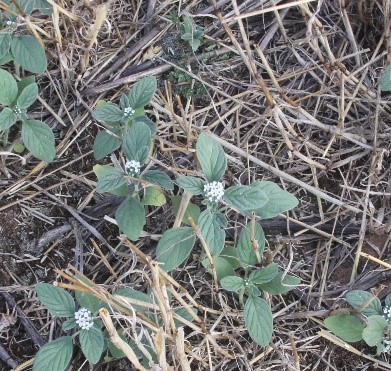Chronic heliotrope poisoning
Author: Dr Jeff Cave, District Veterinary Officer, Agriculture Victoria
Do you have heliotrope in your pastures or stubble? Do you wonder what it might do to your sheep if they graze it?
Heliotrope is commonly found in stubbles, fallows, and degraded pastures after summer rains. It contains a toxin known as a pyrrolizidine alkaloid. The same toxin is found in Paterson’s curse.
Pyrrolizidine alkaloids cause liver damage. This may lead to liver failure or, more commonly, impaired copper metabolism leading to a build-up of copper in the liver. In many cases, limited exposure to heliotrope appears not to cause overt disease. In areas where heliotrope is abundant most old sheep have livers with changes consistent with pyrrolizidine alkaloid poisoning. Chronic copper poisoning, also known as toxaemic jaundice, generally occurs only in sheep which have ingested significant amounts of heliotrope, usually but not exclusively over a period of several years. In such cases chronic copper poisoning may kill 10–30 per cent of a flock.
Effective strategies for the control of pyrrolizidine alkaloidosis include grazing management, breed selection, the reduction of copper absorption using molybdenum and sulphate, and chemical and biological control of the plants. On properties where heliotrope is resulting in chronic copper poisoning in older sheep, a common recommendation is to keep the older breeding stock off the worst affected paddocks and use those paddocks to graze lambs and other sheep that are going to be sold at a younger age.
Crossbred sheep are much more likely to be affected than merinos due presumably to their grazing habits. In some areas, producers limit their risk of disease by running merino sheep only (Salmon 2012). As cattle are much more susceptible to pyrrolizidine alkaloid intoxication than sheep, it is surprising that they are not affected more frequently. It may be that heliotrope is less palatable for cattle and it may also be because cattle are less likely to be grazed on heliotrope infested summer cropping paddocks.
Chronic copper poisoning is most likely to occur when feeding pasture with high copper levels such as clover dominant spring pastures, or when sheep are supplemented with copper. In such cases, stored copper is suddenly released from the liver leading to a haemorrhagic crisis. Chronic copper poisoning usually presents as sudden death with most affected animals usually dying within hours. Affected animals show severe jaundice seen as yellowing of the whites of the eyes, gums, and internally the fat – hence the more colloquial name of the condition “yellows”. On post-mortem affected sheep also display a dark liver, black kidneys and red urine.
Molybdenum has been observed to reduce copper availability and a home brew of sodium molybdate and sodium sulphate has been used extremely successfully to prevent outbreaks of chronic copper poisoning and to almost immediately prevent further deaths in the face of an outbreak. A product for the treatment of your sheep can be obtained through your veterinarian by a permit found at https://permits.apvma.gov.au/PER10752.PDF
The control of heliotrope involves integrated pest management using a combination of pasture management, grazing management, cultivation, and chemical control, noting that it is difficult to eradicate. It is normal practice to control weeds on summer stubbles and fallows with herbicides as these weeds deplete soil nutrients and water prior to a winter crop.
In conclusion, on properties where heliotrope poisoning is an issue an integrated approach is needed to control its effects. For further information please contact your local veterinarian or Agriculture Victoria Veterinarian or Animal Health Officer, or in NSW your Local Land Services.
References
Salmon, D. 2012. ‘Pyrrolizidine alkaloid poisoning of sheep.’ Flock and Herd.
Watt, B, and Payten D. 2010. ‘Pyrrolizidine alkaloid poisoning in cattle – case 2.’ Flock and Herd.
